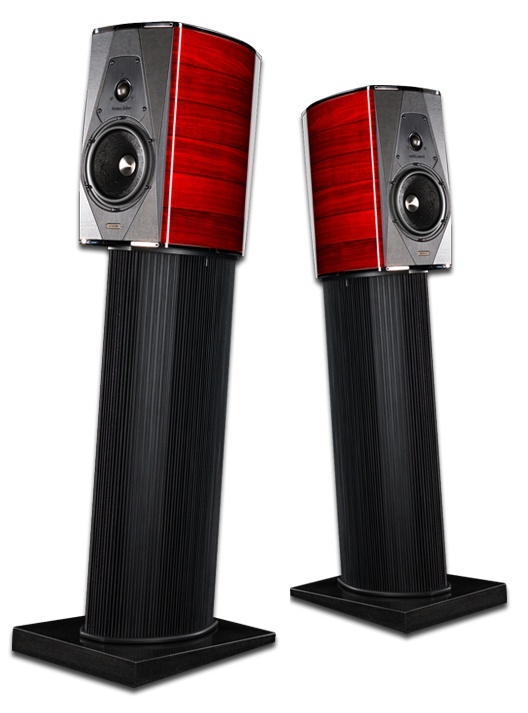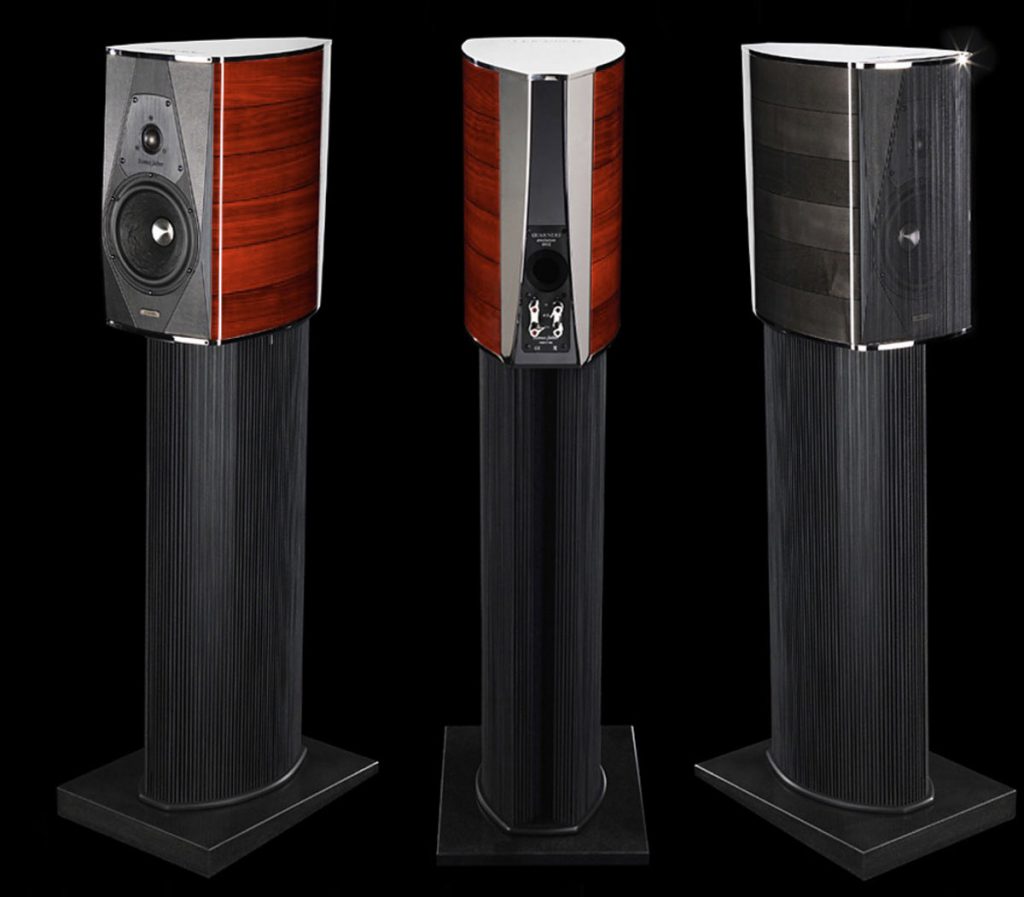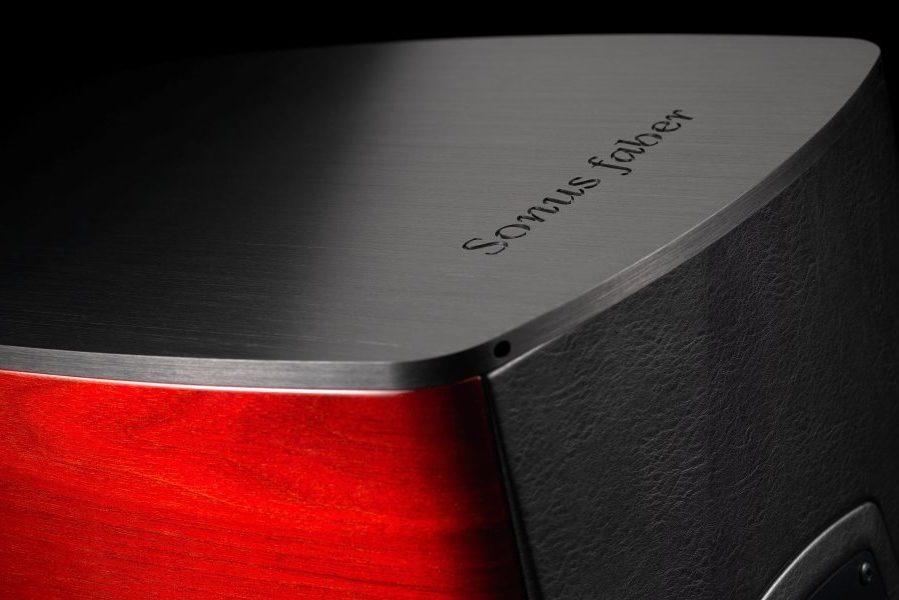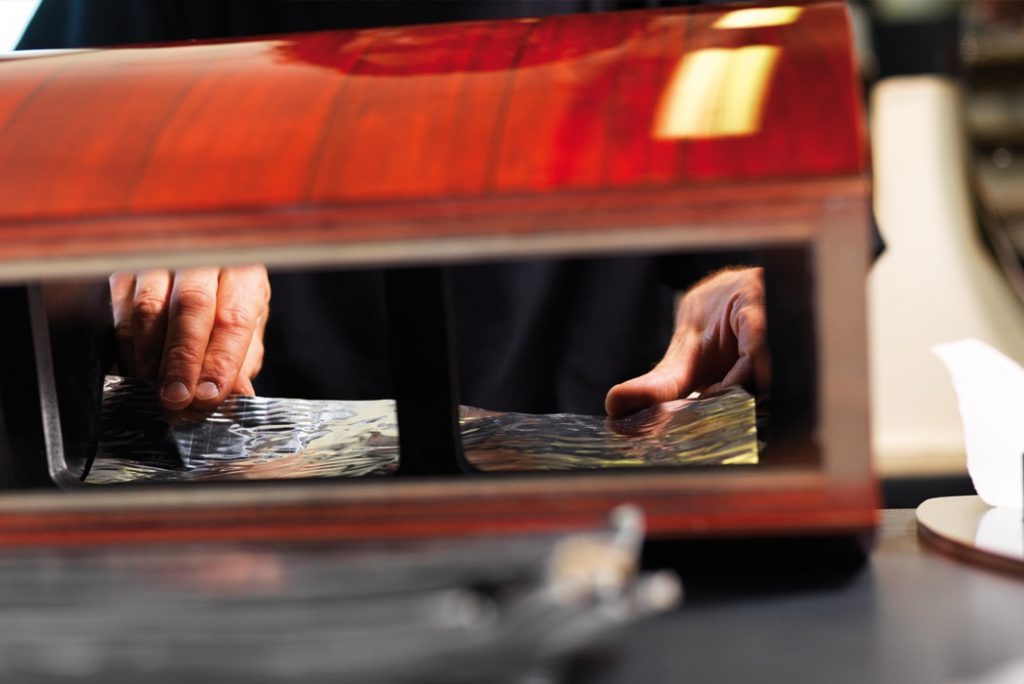Money should never be the first issue in dealing with audio products that have so clearly been directed to exclusive highend markets such as the Sonus Faber Guarneri Evolution. Sometimes, however, money may help to get in touch with the essence of such a product.
I once asked a loudspeaker designer & manufacturer what would be the market price of a 2-way standmount loudspeaker armed with a 5-6 inch mid/woofer, if he had no budget constraints whatsoever, ie. if he could design such a speaker without worrying about how much it will cost to the end user. The answer was 5000-6000 euro. Anything beyond would not, according to him, be conducive to the goodness of the speaker in any way but be something “extra”. Whatever that is.
He may be right. There seems to be a limit to what can be achieved with the popular 2-way standmount monitor concept. At least the marginal utility comes down very rapidly. The most notable limitation is reduced bass energy from a reflex ported 10-15L cabinet. Very often designing such a speaker reduces down to just getting hold of the best possible driver units and passive components, optimizing the crossover for the best integration of the two drivers, and making the enclosure sonically as invisible as possible.
To do that and ask much more than 5-6 kiloeuro for a pair can be argued only with a certain difficulty technically speaking. Even 5-6 kiloeuro seems too much but there are a couple of commercial top-of-the-line 2-way standmount monitors that do trade for that amount of money: Kef Reference 201/2, B&W 805 Diamond, Focal Diablo Utopia, to mention just a few.
This is not to say that all 5 kiloeuro standmount speakers, or the more luxurious ones, would sound the same. After all, they are different loudspeakers. The point is rather that beyond this price roof it makes less and less sense, if at all, to seek objective betterness in the overall technical or sonic performance. Many standmount speakers sound outstanding for just a half the price.
Where’s the beef?
So when a 2-way standmount loudspeaker cost well over 10000 euro, 15900 euro in the case of Sonus Faber Guarneri Evolution, the natural reaction is to ask, without moralizing, what possibly explains the two three times higher price?
In the case of Guarneri Evolution, there are some obvious answers. One is the famous massive stand with a marble foot. The ‘supporting column’, as the manufacturer calls it, is optional but sine qua non both sonically and aesthetically. The special stand is treated against spurious resonances and suspended in order to enhance the speaker/floor decoupling. Yet it would be a total miss to explain the price difference by the stand.
Has Sonus Faber invented some groundbraking techniques that elevate the sound quality of a 2-way monitor to an unprecedented level? No. True, Sonus Faber has taken certain techniques such as vibration killing in the cabinet to the extreme but that’s not enough to account for the difference in economics.
Has the “extra” bread gone into tuning the outfit? This is a tempting hypothesis because Sonus Faber loudspeakers are iconic of Italian perfection in style and finishing; and the Guarneri Evolution, like all other items from the Sonus Faber collection (Sonus Faber refuses to call its speakers as “products”), is no exception. The Evolution looks gorgeous, but appearance alone hardly explains the ‘gap’.
The right answer is, I believe, that objects such as the Sonus Faber Guarneri Evolution communicate in different ways and on different levels. Rather than asking whether the money’s gone to this or that source, what should draw our attention is the narrative around the speaker. The narrative contains not just quasi-revelations of technical details, praising words about its design features, rumours about its sonics, but also: the strong spirit behind the speaker, springing from 250 years of Italian violin making. When Sonus Faber launched its first Guarneri 20 years ago, the Homage, it launched an entire story. That’s where the extra money goes.

Sonus Faber Guarneri Evolution
Against this background it was arresting to discover that the Guarneri Evolution appears to go against the Guarneri narrative, technically, aesthetically, and even sonically. Whether the differences were significant enough to suggest a departure from the Guarneri tradition also spiritually, we’ll see later.
Like the Guarneri Homage (1994) and the Guarneri Momento (2005), the Guarneri Evolution is a 2-way reflex-ported stand mount speaker with ScanSpeak drivers.
That’s where the identity ends. As to the drivers, the most significant change is that the mid/woofer has grown to 179 mm (7 inch), as compared to the 150mm of the Guarneri Memento. Also, the cone is now air dried and non pressed cellulose fiber, not polypropylene or carbon as in the previous versions.
Along with the Stealth reflex loaded bigger mid/woofer the Guarneri Evolotion has not only grown physically (4cm taller, wider and deeper than the Homage) but has risen to a upper performance category, from leight weight to middle-weight, to take in 200W punches (peak power) instead of 100W of the Homage.
The sonic effect of this maturation is twofold: the overall impact of the sound is greater now and the bass is more believable – provided that subjective ex post facto evaluation is accepted. The Evolution sounds like the Guarneri Homage stuffed with a turbo engine. All sorts of modesty and bashfulness is gone.
Regarding the bass, while the previous versions, the Homage especially, trusted on human ear’s ability to detect the bass fundamental from the 2nd harmonics (eg. 50Hz from the 100Hz), the Evolution reproduces mid-to-upper bass pitches with ease. Qualitively it’s not the kind of well breathing bass that can be obtained from a 15″ woofer but quantitatively the bass of the Evolution is such that only very few recordings suffer a lack of it.
In this regard the Evolution definitely provides more value for the money than the previous models, including the Memento. But note: part of the magic of the Homage in particular, was to pay a over then ten grands for a speaker that hardly can do 70Hz! – and still be satisfied.

More metal
The lute shaped cabinet has undergone both internal and external changes. From the viewpoint of the Guarneri narrative, what goes in the cabinet is at least as central as outer characteristics, and I don’t mean only such technically coloured features as multilayer, constrained-mode damped sheets, strategically placed sub-structural ribs etc.
I’d rather point to facts about the woodwork, eg. that the wood layers (laminates of African okoume) that give the enclosure its form are hand selected, quality graded and most notably, carefully oriented for optimized resonances control. In this respect the Guarneri Evolution, like the previous versions, resembles hand-made chronographs, in which tiny invisible parts beneath the clock face are beautifully ornamented.
Externally by far the most significant difference between the Evolution and its predecessors is the new exo-squeleton clamp structure (‘Anima Legata’ borrowed from “The” flagship) with a tuned mass damper to eliminate the residual resonances of the wooden structure. That’s why the Evolution has nickel-plated aluminium top and bottom plates tightened together to an optimal degree by two metal rear wings.
The metal clamp structure gives an entirely new visual look to the Guarneri loudspeaker. The Evolution is no more easily conceived as that humble piece of lutherie what the earlier Guarneris were. The Evolution looks bolder. It looks more dynamic and speedy, more trendy, more contemporary. More urbane, more deluxe.
The Guarneri Evolution makes an apparition in the living room. But luckily enough it doesn’t look self-assertive or intrusive or pompous. One reason may be that the system as a whole is better proportioned now in terms of the speaker/stand ratio. In this regard, it was possible to look at the Homage with benign humour. The stand of the Evolution is lower, and the rake angle has been increased.
More universal, less intimate
When I first heard the Sonus Faber Guarneri Homage, fifteen years ago, the presenter had chosen Sibelius’ Finlandia as the programme music. I remember of having been genuinly surprised of how well the Homage, not only disappeared from the scene, but served the orchestral piece despite the obvious lack of low frequency content.
The Evolution does not disppear to the same degree (as could be expected from a larger cabinet) but it certainly has more resources to reproduce orchestral and any other massive music material with the required power and scale. By all measures, the Evolution is the most universal sounding of the three Guarneris. Whether its tone is too sophisticated for the heaviest heavy, is a matter of taste.
But the extended bass and the resulting comprehensiveness of the sound has its flip-side: the openness of the midrange. The Evolution appeared to be quite sensitive to positioning in this regard. I tried various toe-in angles including no toe-in at all, and chose the angle, not on the basis of the properties of the soundstage, but depending on where the midrange was purest and best represented.
Likewise I experimented with different distances from the rear wall not just for the best bass extension and quality but to get the mid-range tonally right, open and bright enough. The Evolution is not strictly speaking dark sounding but it’s less mid-rangy than the Homage (again for somewhat obvious reasons), and therefore calls for more attention in this repect.
Once all the preparations were settled, and the speakers ideally positioned, I heard a well-balanced, clean and distortionless sound; a smooth sound that was slightly filtered but briskly – not nervously – reacting to music’s dynamic and speed variations. In short, I heard a quality sound that ensured risk-free listening to a wide variety of music from pop/rock to classic.
As to the latter, I heard well-defined timbres of string instruments, I heard fabulously reproduced vocal music, critical as it was to the openness of the sound. And so on. This all was very appealing indeed, and I don’t think it can be denied that the Guarneri Evolution offers a high-level performance consistently from a music sample to another.
The Evolution is a 86dB/4 ohm design. I first drove the speakers with 35W A-Sound Classic push-pull tube integrated, and perceived no problems, not even in the bass. At some point I then decided to try a more powerful transistor amplifier, and chose MM-Audio MiniCombo, a 2x180W Class D integrated, for the job.
Given the high quality of the sound with the A-Sound tube amplifier, it was startling to hear how the solid state amp complimented the Evolutions even better. Not tonally but with regard to how effortlessly the music flowed with no signs of untimely decay. I got the impression that the Evolutions love to be dominated by muscular amplifiers.
Respecting the spirit
With all the new qualities, internal and external, technical and sonic, is the Evolution still the same Guarneri with which Sonus Faber once amazed the audio-land? Has it matured, as Sonus Faber put it, “to superior levels of quality, without undermining the original spirit”?
When one actually experiences the superbly built and finished Evolutions standing proudly on their dedicated pedestals in front of the listening seat, one cannot err about their origin. In this regard the Evolution definitely is that luxurious 2-way monitor, which audiophiles visualize in their head when they hear the name Sonus Faber Guarneri.
But it’s also true that the Evolution is spiritually more technical than the earlier versions, and communicates it both visually and sonically. Where the Memento and the Homage still belonged to the old Guarneri school, the Evolution leans more strongly to the design philosophy of the large Sonus Faber floorstanders.
The Sonus Faber Guarneri Evolution is not the only loudspeaker of its kind. In the same gang are, eg., Magico Mini II (30000 USD), Wilson Audio Duette (13000 USD), Krell Modulari Primo (20000 USD), and why not TAD Compact Reference One (30000 USD), even though it’s a 3-way. These all are very special loudspeakers. All of them have their own story to tell us, and for all of them there are people who see them in the right light. To these people, sonics is just a variable among many, and so is the price.
If I should make a guess, people who see the Sonus Faber Guarneri Evolution in the right light, and with whom the speaker has least communication gaps, fancy perfection in other fields of life as well, and are on average better enlightened in matters of aesthetics and industrial design.
Sonus Faber Guarneri Evolution
SYSTEM: 2 way, stealth reflex loaded, compact monitor on a dedicated stand.
CABINET: multilayer, constrained-mode damping, hand selected wood layers, exo-squeleton clamp structure.
TWEETER: 29 mm classic Ragnar Lian moving coil driver.
MIDRANGE/WOOFER: 179 mm, air dried and non pressed cellulose fiber cone.
CROSS-OVER: 2800Hz, non-resonant “progressive slope” design, “Paracross topology” on the tweeter hi-pass. Mundorf “Supreme” capacitors, Jantzen inductors.
FREQUENCY RESPONSE: 40 Hz – 30.000 Hz, stealth reflex included.
SENSITIVITY: 86 db SPL (2.83V/1 m).
NOMINAL IMPEDANCE: 4 ohm.
POWER HANDLING: 25W – 200W.
DIMENSIONS: 410 x 235 x 412 mm (HxWxD).
NET WEIGHT: 37 Kg per pair.
OPTIONAL DEDICATED STAND: 795 x 320 x 423 mm (HxWxD); netweight: 72 Kg per pair.
TOTAL DIMENSIONS: 1205 x 320 x 510 mm (HxWxD)









